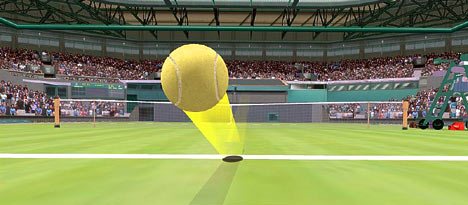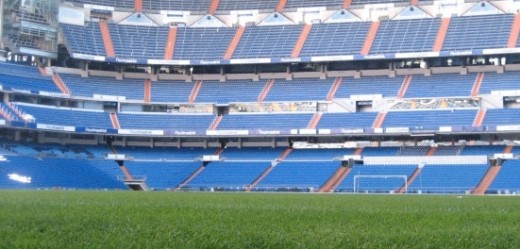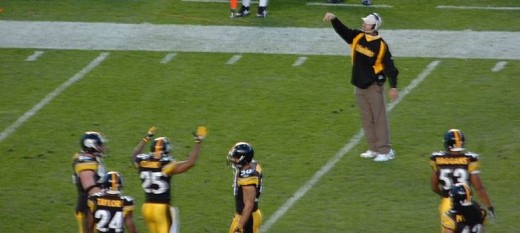
Top athletes are increasingly turning to technology as they strive to stay ahead of the game. From iOS-connected football boots, to data-driven tennis racquets, we’re seeing a real shift towards digitally-enhanced sportspeople.
Indeed, the so-called Internet of Things is seemingly becoming a reality. This concept describes the trend for environments, buildings, vehicles, clothing, portable devices and other objects (or ‘things’…) having information associated with them, and be able to sense, communicate, network and produce new information. The idea is that a global spread of an ‘Internet of Things’ could ultimately transform how we live our lives and the way we interact with the physical world.
But sticking to the athletic sphere, there are clear disparities between how technology is used across the sporting spectrum. And this is perhaps best exemplified in football – or ‘soccer’, if you must.
Robotic refs
On a number of occasions, poor refereeing decisions catapult football’s lack of technological sophistication into the spotlight.
Now, the pros and cons of introducing the likes of goal-line technology and instant replays, are well understood. In favour? Well, with so much at stake in the modern game, we simply can’t let human error control the outcome of lucrative fixtures in domestic leagues, pan-European fixtures and international tournaments.
And against? Technology will remove the excitement of controversy, while simultaneously slowing down what is typically regarded as a fast-paced, instantaneous game.
It would be easy to run through the full ins and outs of said arguments to reach a reasoned conclusion as to the best way to proceed. But that’s well-worn ground. What I’d really like to ask is this – will introducing technology really make that big a difference to the outcome of games? Will it stop post-match squabbling in pubs and pundits’ studios? Will it really remove doubt and ensure that the rightful team always emerges victorious?
Whilst it’s difficult to argue against introducing at least some form of technology to aid refs in the beautiful game, I really can’t help but think people are overstating the impact it will have. And here’s why.
Goal-line technology
The elephant in the room here is goal-line technology. There is nothing worse in football than losing a match because a goal was given against your team when the ball didn’t cross the line. Or a crucial equalizer was denied when your team did manage to poke the ball over the line, but the referee and his assistants missed it.
Some argue that it is part and parcel of the game – it always has been like that, what goes around comes around. Every team gets the rub of the green at some point, right?
Case in point – in 2010 England’s Frank Lampard was cruelly denied a goal against Germany in the World Cup, after the ball had crossed the line by at least 4 miles. But two years later, England struck it lucky against the Ukraine in Euro 2012 when a goal wasn’t given against them, when it had crossed the line. Then there was that goal in the 1966 World Cup final which played a pivotal role in England’s eventual victory.
Throw into the equation Maradona’s sublime *cough* header in the 1986 World Cup quarter final and, well, you can see that Lady Luck generally does spread herself around. By luck, of course, we mean incompetence.
But let’s stick specifically to the subject of goal-line incidents. During a typical season in any of the top leagues of the world, how many controversial decisions actually occur? How many times does the full ball cross the line and a goal isn’t given, and how many times does it fail to cross the line and it is given? Within each league, you can count them on one hand – possibly even a few fingers.
I’m not saying the powers-that-be shouldn’t invest and roll-out goal-line technology across the major leagues of the world, all I’m saying is that it isn’t solving a rampant problem. Nowhere near as rampant as, say, tennis.
Hawk-Eye, tennis and other sports

It has been an awesome summer of sport so far – the French Open, the Euros, Wimbledon, the Tour De France…and the Olympics aren’t even underway yet. But some of these sports are perfectly juxtaposed against each other in terms of their use (or lack, thereof…) of technology.
Hawk-Eye, if you didn’t know, is pretty accurate technology used in tennis, cricket and others sports. It figures out the trajectory of the ball to determine where it hit the ground. At Wimbledon, a lawn tennis tournament, it’s impossible to see where the ball hits the ground because it doesn’t leave a mark on the surface, as it does on the clay courts of the French Open.
Given that tennis is a relatively straight forward sport in terms of rules – the ball is either in or it’s out – it’s far more important to use technology. With all the line judges in the world, a 135mph serve renders it pretty difficult to confidently declare a ball in or out if it hits an inch or two either side of the line. And anyone who even remotely follows tennis will know how many shots in tennis hit a 50mm radius around one of the lines.
It was recently noted that based on players challenging decisions with Hawk-Eye data, Wimbledon linesmen got a staggering 27% of their line calls wrong. Hawk-Eye is such an important part of Wimbledon now for this very reason.
Transpose that statistic onto football, and there would be absolutely no argument that goal-line technology would be needed. That would be almost one in three goals that the referee and his assistant would call wrong.
But alas, most goals end up rustling the back of the net, leaving absolutely no question as to the right decision to make. If the public want goal-line technology, give them goal-line technology, but don’t use tennis as an argument for its use – they’re completely different sports with different needs.
With the 2012 London Olympics about to get underway, it too helps to show the need for technology in some sports. Take the 100m sprint – the starting blocks are electronically linked up to help judges identify false starts, as well as the respective times of the runners.
At the finish line there is a camera too, which helps determine who crossed the line and in what order. As with tennis, this is essential for the sport – we’re talking about such small measurements here, a millisecond or millimeter here or there can be the difference between a gold medal and finishing last.
This level of precision is rarely needed for goals in football. But alas, goal-line technology has been the given the go-ahead (but maybe not in European competition whilst Platini is at UEFA’s helm), and we will likely see it used by the time the next World Cup comes ’round. And when it does help inform a correct decision, people will view it as vindication – but there will be very few instances where it will step in and save the day.
Beyond goal-line technology: Rule interpretation
Of course, the pro-technology argument for football extends far beyond that of goal-line technology. Whilst tennis is a black-and-white sport from a rules perspective (the ball was either ‘in’ or it was ‘out’), a referee’s job in football is fraught with crucial decisions at every turn.
Free-kicks, penalties, off-side, fouls, yellow cards, red cards, drop-balls, throw-ins, goal-kicks, corners…the list could go on. If tennis is tiddly-winks, then football is akin to playing hopscotch on a minefield on the decision-analogy front.
Those against introducing instant replays into football to help referees make more informed decisions, usually argue that it would slow the game down and make it less exciting for the spectator. I don’t necessarily go along with that though. I think that it could be possible to implement a system whereby the referee has remote access to an assistant sat behind a screen, and if he has any shred of doubt over a decision, he can call for help. It could take no more than 5-10 seconds. Granted, over the course of a match, those 5-10 seconds would certainly mount up.
Where I’m coming from, however, is that so many rules in football are about interpretation – they’re not cut-and-dry calls. And here’s the thing – we already do have access to instant replays during live football matches. Fans, commentators and pundits are privy to real-time playbacks of contentious decisions, but does this mean that we all agree with what the correct decisions should have been?
Hours are spent on post-match analysis, action is slowed down and repeated ten times to try and reach conclusive decisions. Sometimes, yes, it can help shed light on a situation. But there are still so many incidents where it simply doesn’t result in conclusive proof.
Did the defender kick the ball before bringing the striker down in the box? Did the player deliberately block the ball with his hand, or did the ball accidentally strike his hand? Was that stray forward really interfering with play when the linesman flagged for offside?
Interpretation is such a huge part of football rules. You can have all the instant replays in the world, and it will rarely lead to happy, congruent fans and pundits.
But I would love to see refs have some access to the same replays we all have at home. Goal-line technology could be a very expensive folly – by giving the fourth officials access to the same footage that we all have at home, it would save a lot of money and maybe just a little heartache when it correctly calls a goal.
Here’s another idea – why not take a leaf from the NFL’s book, where a set number of challenges can be made to decisions, using instant replays? It helps keep things exciting, and ensures that not every single call from the ref is scrutinized in real-time. A similar system exists in tennis with Hawk-Eye, where players have three challenges per set, which they keep as long as the umpire’s decision is proven to have been wrong.
So give football captains or managers a set number of challenges in a game – when there is a suspicion that the ref has made an absolute howler, they can pull him up on it.
Football probably does need some form of technology introduced to help referees. There is certainly demand for it, and that’s why we will start seeing more technology used in the game in the near future. But don’t be fooled for a second that it will solve football’s problems.
The arguments will still ensue, and fans, players and managers will still claim the referee ‘got it wrong’. But that’s what makes football so exciting, right?
Get the TNW newsletter
Get the most important tech news in your inbox each week.






